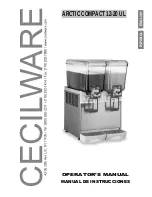
EN
SBBI-21-044-T (10/2015)
2 / 8
SAFETY PRECAUTIONS
This manual contains information that is important for you to know and understand. This information relates to USER SAFETY and
PREVENTING EQUIPMENT PROBLEMS. To help you recognize this information, we use the following symbols. Please pay particular
attention to these sections.
Important information that tells how to pre-
vent damage to equipment, or how to avoid
a situation that may cause minor injury.
Note
Information that you should pay special
attention to.
Important safety information – A hazard
that may cause serious injury or loss of life.
The following hazards may occur during the normal use of this equipment. Please read the following chart.
HAZARD
CAUSE
SAFEGUARDS
Fire
Solvents and coatings can be
1. Adequate exhaust must be provided
highly flammable or combust-
to keep the air free of accumulations
ible, especially when sprayed.
of flammable vapors.
2. Smoking must never be allowed in
the spray area.
3. Fire extinguishing equipment must
be present in the spray area.
Fire - Pressure Tank
Vapors from flammable liquids
1. Keep tank at least 10 feet away from
can catch fire or explode.
sources of ignition. Ignition sources in-
clude hot objects, mechanical sparks,
and arcing (non-explosion proof) elec-
trical equipment.
InhalingToxic Substances
Certain materials may be harm-
1. Follow the requirements of the Material
ful if inhaled, or if there is con-
Safety Data Sheet supplied by your
tact with the skin.
coating material manufacturer.
2. Adequate exhaust must be provided to
keep the air free of accumulations of
toxic materials.
3. Use a mask or respirator whenever
there is a chance of inhaling sprayed
materials. The mask must be compat-
ible with the material being sprayed and
its concentration. Equipment must be
as prescribed by an industrial hygienist
or safety expert, and be NIOSH ap-
proved.
Explosion, Pressure
Making changes to pressure
1. Never drill into, weld, or modify tank in
Tank - Rupture
tank will weaken it.
any way.
2. Do not adjust, remove, or tamper with
the safety valve. If replacement is nec-
essary, use the same type and rating
of valve.
General Safety
Improper operation or mainte-
Operators should be given adequate training in
nance may create a hazard.
the safe use and maintenance of the equip-
ment (in accordance with the requirements
of NFPA-33, Chapter 15 in U.S.). Users must
comply with all local and national codes of
practice and insurance company require-
ments governing ventilation, fire precautions,
operation, maintenance and housekeeping
(in the U.S., these are OSHA Sections 1910.94
and 1910.107, and NFPA-33).


























